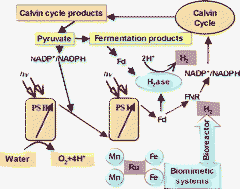Hydrogen photoproduction by use of photosynthetic organisms and biomimetic systems
Abstract
Hydrogen can be important clean fuel for future. Among different technologies for hydrogen production, oxygenic natural and artificial photosyntheses using direct photochemistry in synthetic complexes have a great potential to produce hydrogen, since both use clean and cheap sources: water and solar energy. Artificial photosynthesis is one way to produce hydrogen from water using sunlight by employing biomimetic complexes. However, splitting of water into protons and oxygen is energetically demanding and chemically difficult. In oxygenic photosynthetic microorganisms such as algae and cyanobacteria, water is split into electrons and protons, which during primary photosynthetic process are redirected by photosynthetic electron transport chain, and ferredoxin, to the hydrogen-producing enzymes hydrogenase or nitrogenase. By these enzymes, e− and H+ recombine and form gaseous hydrogen. Biohydrogen activity of hydrogenase can be very high but it is extremely sensitive to photosynthetic O2. In contrast, nitrogenase is insensitive to O2, but has lower activity. At the moment, the efficiency of biohydrogen production is low. However, theoretical expectations suggest that the rates of photon conversion efficiency for H2 bioproduction can be high enough (>10%). Our review examines the main pathways of H2 photoproduction by using of photosynthetic organisms and biomimetic photosynthetic systems.

- This article is part of the themed collection: Photosynthesis from molecular perspective: towards future energy production

 Please wait while we load your content...
Please wait while we load your content...